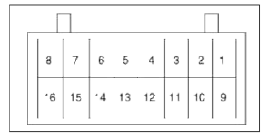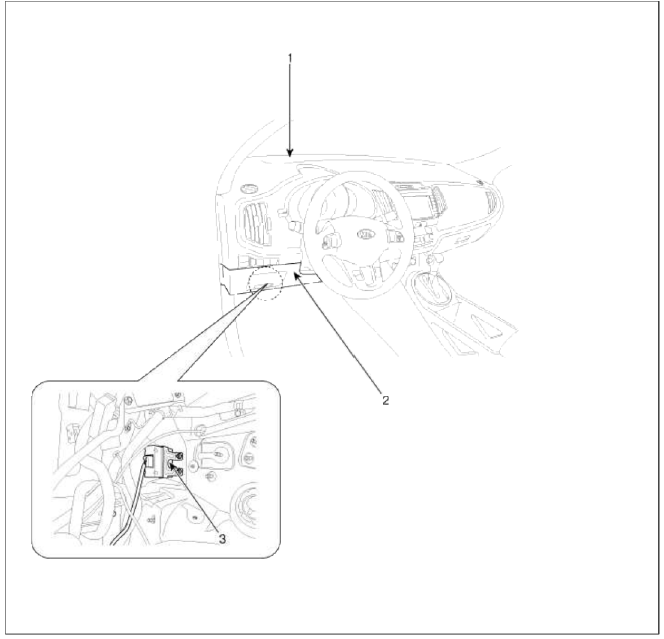Kia Sportage: Description and Operation, Flow Diagram | Schematic Diagrams | Components and Components Location, Repair procedures
Description and Operation
Description
4WD ECU processes signals from various sensors and determines the current road and driving conditions. The ECU then utilizes this information to implement precision control over the 4WD coupling's multi-plate clutch and variably adjust the amount of torque delivered to the rear wheels.

Flow Diagram
Power Flow Diagram

4WD ECU Input&Output Diagram

Schematic Diagrams
Circuit Diagram
4WD ECU Connector

- Oil pressure motor A
- Oil pressure motor Ð’
- Lock mode switch
- -
- Input sensor signal (+)
- -
- CAN communication line (High)
- CAN communication line (Low)
- -
- -
- -
- IG power
- Ground
- Battery power
- Input sensor signal(-)
- Pressure sensor (Input)
- -
- -
4WD ECU Circuit Diagram

Components and Components Location, Repair procedures
Components and Components Location
Component Location

- Crash pad
- Crash lower panel
- 4WD ECU
Repair procedures
Replacement
CAUTION
Prior to replacing the 4WD ECU, check the 4WD ECU's clutch learing with the GDS tool. (Refer to "Coupling assembly" in 4WD group)
1. Remove the lower panel. (Refer to "Crash Pad" in BD group)
2. Remove the IPM. (Refer to "Fuses and Relays" in BE group)
3. Remove the parking brake pedal. (Refer to "Parking Brake System" in BR group
4. Remove the 4WD ECU (C) after removing the nut (A-2ea) and the connector (B).
Tightening torque: 9.8 ~ 11.8 N.m (1.0 ~ 1.2 kgf.m, 7.2 ~ 8.7 lb-ft)

5. Installation is the reverse of removal.
CAUTION
Prior to installing a new ECU, upload the original ECU's clutch learing to the replacement ECU using the GDS tool. (Refer to "Coupling assembly" in 4WD group)
READ NEXT:
SEE MORE:
 Rear Parking Assist System Control Unit
Rear Parking Assist System Control Unit
Specifications
Specifications
The BCM contains the rear parking assist system function.
Components and Components Location
Component Location
First alarm: Object comes near to the sensor located at the rear of
vehicle, within 81-120cm +- 15cm
Second alarm: Object comes n
 Filler-Neck Assembly | Accelerator Pedal | Delivery Pipe
Filler-Neck Assembly | Accelerator Pedal | Delivery Pipe
Repair procedures
Removal
1. Remove the rear-LH wheel, tire, and the inner wheel house.
2. Disconnect the fuel filler hose (A) and the ventilation hose (B).
3. Open the fuel filler door and unfasten the filler-neck assembly mounting screw (A).
4. Remove the filler-neck assembly from the ve
Content
- Home
- Kia Sportage - Fifth generation (NQ5) - (2022-2025) - Owner's Manual
- Kia Sportage - Second generation (JEKM) (2005-2015) - Body Workshop Manual
- Kia Sportage Third generation (SL) - (2011-2016) - Service and Repair Manual
- Sitemap
- Top articles